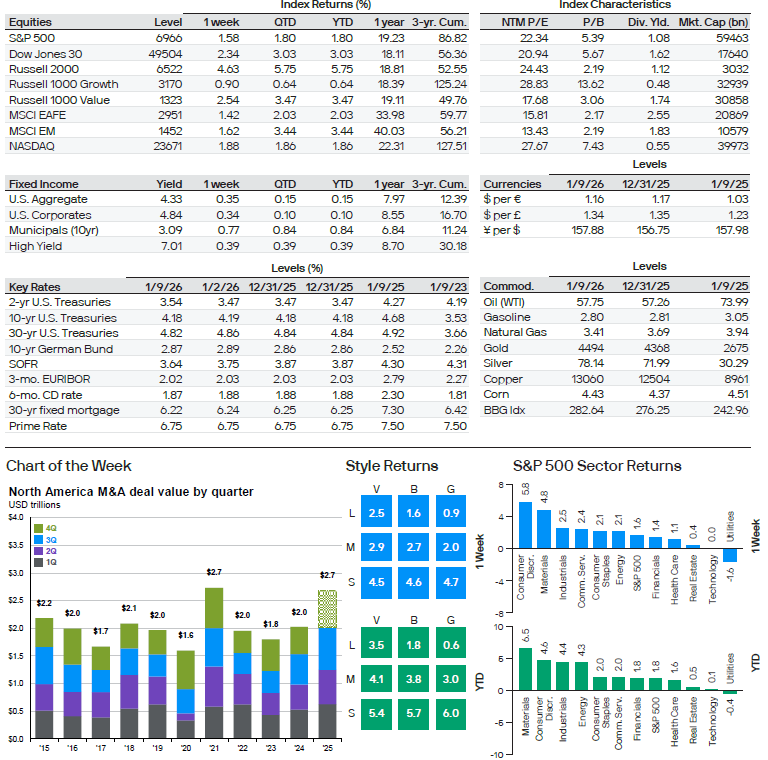The 5 Elements of Financial Wellness
Financial wellness is a term that refers to the overall health and well-being of an individual's finances. In order to achieve financial wellness, it is essential to understand and manage the five key elements of personal finance: spending, saving, borrowing, planning, and protecting.
Let's Team Up
Achieving financial wellness is a process that requires a holistic approach. By understanding and managing the five key elements of personal finance, you can take control of your finances and create a better future for yourself and your family. Remember, it's never too late to start making changes to your finances and take the first step towards financial wellness.
The opinions voiced in this material are for general information only and are not intended to provide specific advice or recommendations for any individual.
This material was prepared by Financial Media Exchange for Nate Wyatt and the Investment Service Center’s use.
Copyright © 2025 FMeX. All rights reserved.
Heading into 2026, absent any major market shocks, the pieces are in place for one of the strongest years for North American M&A and IPO activity we have ever seen. Favorable economic conditions, an increasingly permissive antitrust agenda in Washington and cheaper financing costs should make it easier to facilitate transactions, with companies now operating in one of the most pro-business deal-making environments in years.
If this sounds familiar, that’s because these are very similar to the reasons why markets expected a rebound in deal activity in 2025. Sure enough, and as shown in this week’s chart, annualized 2025 North American M&A deal value is on pace to be 32% higher than in 2024 – and nearly equivalent to the record total set in 2021. Now, in 2026, with tariff uncertainty fading and rates 75 basis points lower than they were at the start of 2025, confidence among business leaders is growing. According to an annual Citizens Bank survey, sentiment for a robust deal environment is at a six-year high, with nearly 60% of companies characterizing the current M&A environment as “somewhat or extremely strong.” For IPO markets, in addition to the same tailwinds expected to boost M&A, continued strength in equity markets, a sizable backlog of older-vintage private-equity-owned companies in the pipeline and several large, high-profile private companies expected to go public are spurring optimism this year.
With these favorable conditions in place, companies are poised to continue taking advantage of a sustained window for deal activity. Strong M&A and IPO activity is positive for investments in private equity and venture capital, which can serve as a diversified source of growth within portfolios.

Chart of the Week: Source: PitchBook Data, Inc., J.P. Morgan Asset Management. 4Q25 M&A deal value is annualized.
Thought of the Week: Source: Citizens Bank, PitchBook Data, Inc., J.P. Morgan Asset Management.
Index: Institute for Supply Management Manufacturing Index; PCE: Personal consumption expenditures; Philly Fed Survey: Philadelphia Fed Business Outlook Survey; PMI: Purchasing Managers' Manufacturing Index; PPI: Producer Price Index; SAAR: Seasonally
Adjusted Annual Rate
MSCI EAFE is a Morgan Stanley Capital International Index that is designed to measure the performance of the developed stock markets of Europe, Australasia, and the Far East.
Bond Returns: All returns represent total return. Index: Bloomberg US Aggregate; provided by: Bloomberg Capital. Index: Bloomberg Investment Grade Credit; provided by: Bloomberg Capital. Index: Bloomberg Municipal Bond 10 Yr; provided by: Blomberg Capital. Index: Bloomberg Capital High Yield Index; provided by: Bloomberg Capital.
Key Interest Rates: 2 Year Treasury, FactSet; 10 Year Treasury, FactSet; 30 Year Treasury, FactSet; 10 Year German Bund, FactSet. 3 Month LIBOR, British Bankers’ Association; 3 Month EURIBOR, European Banking Federation; 6 Month CD, Federal Reserve; 30 Year Mortgage, Mortgage Bankers Association (MBA); Prime Rate: Federal Reserve.
Commodities: Gold, FactSet; Crude Oil (WTI), FactSet; Gasoline, FactSet; Natural Gas, FactSet; Silver, FactSet; Copper, FactSet; Corn, FactSet. Bloomberg Commodity Index (BBG Idx), Bloomberg Finance L.P.
information from FactSet's Pricing database as provided by MSCI. Russell 1000 Value Index,
Style Returns: Style box returns based on Russell Indexes with the exception of the Large-Cap Blend box, which reflects the S&P 500 Index. All values are cumulative total return for stated period including the reinvestment of dividends. The Index used from L to R,
top to bottomare: Russell 1000 Value Index (Measures the performance of those Russell 1000 companies with lower price-to book ratios and lower forecasted growth values), S&P 500 Index (Index represents the 500 Large Cap portion of the stockmarket, and
is comprised of 500 stocks as selected by the S&P Index Committee), Russell 1000 Growth Index (Measures the performance of those Russell 1000 companies with higher price-to-book ratios and higher forecasted growth values), Russell Mid Cap Value Index (Measures
the performance of those Russell Mid Cap companies with lower price-to-book ratios and lower forecasted growth values), Russell Mid Cap Index (The Russell Midcap Index includes the smallest 800 securities in the Russell 1000), Russell Mid Cap Growth Index (Measures the performance of those Russell Mid Cap companies with higher price-to-book ratios and higher forecasted growth values), Russell 2000 Value Index (Measures the performance of those Russell 2000 companies with lower price-to-book ratios and lower forecasted growth values), Russell 2000 Index (The Russell 2000 includes the smallest 2000 securities in the Russell 3000), Russell 2000 Growth Index (Measures the performance of those Russell
2000 companies with higher price-to-book ratios and higher forecasted growth values).
Past performance does not guarantee future results.
The J.P. Morgan Asset Management Market Insights and Portfolio Insights programs, as non-independent research, have not been prepared in accordance with legal requirements designed to promote the independence of investment research, nor are they subject to any prohibition on dealing ahead of the dissemination of investment research.
This document is a general communication being provided for informational purposes only. It is educational in nature and not designed to be taken as advice or a recommendation for any specific investment product, strategy, plan feature or other purpose in any
jurisdiction, nor is it a commitment from J.P. Morgan Asset Management or any of its subsidiaries to participate in any of the transactions mentioned herein. Any examples used are generic, hypothetical and for illustration purposes only. This material does not contain sufficient information to support an investment decision and it should not be relied upon by you in evaluating the merits of investing in any securities or products. In addition, users should make an independent assessment of the legal, regulatory, tax, credit, and accounting implications and determine, together with their own financial professional, if any investment mentioned herein is believed to be appropriate to their personal goals. Investors should ensure that they obtain all available relevant information before making any investment. Any forecasts, figures, opinions or investment techniques and strategies set out are for information purposes only, based on certain assumptions and current market conditions and are subject to change without prior notice. All information presented herein is considered to be accurate at the time of production, but no warranty of accuracy is given and no liability in respect of any error or omission is accepted. It should be noted that investment involves risks, the value of investments and the income from them may fluctuate in accordance with market conditions and taxation agreements and investors may not get back the full amount invested. Both past performance and yields are not reliable indicators of current and future results.
J.P. Morgan Asset Management is the brand for the asset management business of JPMorgan Chase & Co. and its affiliates worldwide.
Telephone calls and electronic communications may be monitored and/or recorded.
Personal data will be collected, stored and processed by J.P. Morgan Asset Management in accordance with our privacy policies at https://www.jpmorgan.com/privacy.
This communication is issued by the following entities:
In the United States, by J.P. Morgan Investment Management Inc. or J.P. Morgan Alternative Asset Management, Inc., both regulated by the Securities and Exchange Commission; in Latin America, for intended recipients’ use only, by local J.P. Morgan entities, as the case may be.; in Canada, for institutional clients’ use only, by JPMorgan Asset Management (Canada) Inc., which is a registered Portfolio Manager and Exempt Market Dealer in all Canadian provinces and territories except the Yukon and is also registered as an Investment Fund Manager in British Columbia, Ontario, Quebec and Newfoundland and Labrador.
If you are a person with a disability and need additional support in viewing the material, please call us at 1-800-343-1113 for assistance.
Copyright 2026 JPMorgan Chase & Co. All rights reserved.
©JPMorgan Chase & Co., January 2026.
Unless otherwise stated, all data is as of January 12, 2026 or as of most recently available.
0903c02a81dbac80
| Not Insured by FDIC or Any Other Government Agency | Not Bank Guaranteed | Not Bank Deposits or Obligations | May Lose Value |
|---|



